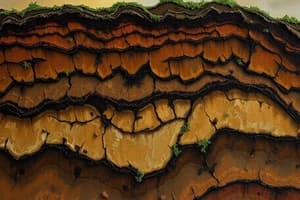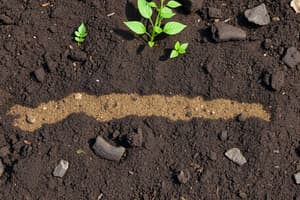Podcast
Questions and Answers
What is the primary difference between soil formation and soil development?
What is the primary difference between soil formation and soil development?
Soil formation refers to the processes and factors that create true soil from parent material, while soil development involves changes in the soil profile due to natural processes like leaching and weathering.
Define a soil profile and its significance in soil science.
Define a soil profile and its significance in soil science.
A soil profile is the vertical face of exposed soil, showcasing all layers from the surface to the parent material, significant for understanding soil properties and horizons.
What are the five factors of soil formation, represented by the acronym CLORPT?
What are the five factors of soil formation, represented by the acronym CLORPT?
The five factors are Climate, Organisms, Parent material, Topography, and Time.
How does climate specifically influence soil formation?
How does climate specifically influence soil formation?
What is a 'pedon' in soil science?
What is a 'pedon' in soil science?
What role do living organisms play in soil formation?
What role do living organisms play in soil formation?
What are the primary processes involved in frost wedging and how do they contribute to physical weathering?
What are the primary processes involved in frost wedging and how do they contribute to physical weathering?
Explain the term 'soil horizon' and its characteristics.
Explain the term 'soil horizon' and its characteristics.
How does time affect soil formation and development?
How does time affect soil formation and development?
Explain the role of bioturbation in soil formation and physical weathering.
Explain the role of bioturbation in soil formation and physical weathering.
Describe how thermal weathering can impact rock formation in different climates.
Describe how thermal weathering can impact rock formation in different climates.
What conditions favor salt weathering and what is its main mechanism?
What conditions favor salt weathering and what is its main mechanism?
How does chemical weathering differ from physical weathering in terms of processes and outcomes?
How does chemical weathering differ from physical weathering in terms of processes and outcomes?
What is the primary effect of hydration on minerals?
What is the primary effect of hydration on minerals?
Describe hydrolysis and its significance in soil formation.
Describe hydrolysis and its significance in soil formation.
What role does oxidation play in the weathering of ferromagnesian minerals?
What role does oxidation play in the weathering of ferromagnesian minerals?
Explain the impact of biochemical weathering on minerals.
Explain the impact of biochemical weathering on minerals.
How does the composition of a rock affect its weathering process?
How does the composition of a rock affect its weathering process?
Identify two changes that can occur in rock color due to weathering.
Identify two changes that can occur in rock color due to weathering.
What is dissolution in the context of rock weathering?
What is dissolution in the context of rock weathering?
How does texture change during the weathering process?
How does texture change during the weathering process?
How do fungi contribute to soil formation?
How do fungi contribute to soil formation?
What are the two main categories of parent materials?
What are the two main categories of parent materials?
Explain the difference between residual and transported parent materials.
Explain the difference between residual and transported parent materials.
What is weathering and its significance in soil formation?
What is weathering and its significance in soil formation?
Identify and define the two types of weathering processes.
Identify and define the two types of weathering processes.
What are the main agents of transported parent materials?
What are the main agents of transported parent materials?
How does topography influence soil formation?
How does topography influence soil formation?
Why is quartz (SiO2) not considered beneficial for soil fertility?
Why is quartz (SiO2) not considered beneficial for soil fertility?
Study Notes
Soil Formation and Development
- Soil formation involves processes and factors transforming parent material into soil.
- Soil development refers to alterations in the soil profile through leaching, translocation, organic matter accumulation, and weathering.
Soil Profile and Horizons
- A soil profile is a vertical section showing all layers (horizons) from the surface to the parent material.
- Soil solum contains roots or is influenced by them.
- Soil horizons are layers differing in physical, chemical, and biological characteristics.
Factors of Soil Formation (CLORPT)
- Soil formation is expressed as Soil = f(clorpt), where factors include:
- Climate (c):
- Influences precipitation and temperature, affecting weathering rates.
- Affects physical weathering via freeze-thaw cycles and temperature variations.
- Living Organisms (lo):
- Both macro and microorganisms contribute, with fungi aiding in rock dissolution.
- Climate and organisms are active factors in soil formation.
- Relief/Topography (r):
- Refers to land surface configuration and topographic position.
- Parent Material (p):
- Serves as the soil's precursor and affects its mineralogy and nutritional status.
- Divided into organic (residues from vegetation) and inorganic materials (rocks and minerals).
- Categories include residual (original location) and transported (moved by natural forces).
- Climate (c):
Weathering Processes
- Weathering consists of chemical, physical, and biological degradation of parent material contributing to soil formation.
- Physical Weathering:
- Breaks rocks into fragments without changing chemical composition.
- Influenced by temperature variations (frost wedging, thermal weathering) and mechanical actions (wind, water, plant roots).
- Chemical Weathering:
- Involves transformation of minerals into simpler forms through processes like hydration, hydrolysis, and oxidation.
Types of Weathering
-
Physical Weathering Examples:
- Frost wedging: Water freezes in rock fractures, leading to disintegration.
- Thermal weathering: Changes from heating and cooling cause rock expansion and contraction.
- Bioturbation: Organisms (e.g. earthworms) break down rocks through burrowing actions.
-
Chemical Weathering Examples:
- Hydration: Water interacts with minerals to alter chemical bonds.
- Hydrolysis: Reaction involving water decomposing minerals and forming clay.
- Dissolution: Acids in water aid the solubility of minerals.
- Oxidation: Loss of electrons from minerals, significantly affecting iron-containing minerals.
Biochemical Weathering
- Microbes and vegetation in the rhizosphere release organic acids, facilitating mineral hydrolysis and nutrient release (e.g., potassium from biotite).
Rock Weathering Changes
- Color: Transformation due to oxidation from grey to red/yellow due to iron oxidation.
- Density: Changes in material amount can lead to density variations.
- Composition: Shifts toward stable mineral forms, affecting solubility and secondary mineral types.
- Fabric or Texture: Transition from rock to soil structures with new development.
Factors Affecting Weathering
- The mineral composition and physical conditions (e.g., particle size) significantly influence weathering rates and processes.
Studying That Suits You
Use AI to generate personalized quizzes and flashcards to suit your learning preferences.
Related Documents
Description
This quiz covers Lesson 3 of Soil Science 1, focusing on the principles of soil formation and development. It explores the processes and factors responsible for forming true soil from parent material, as well as the natural changes in soil profiles due to leaching and organic matter accumulation.




